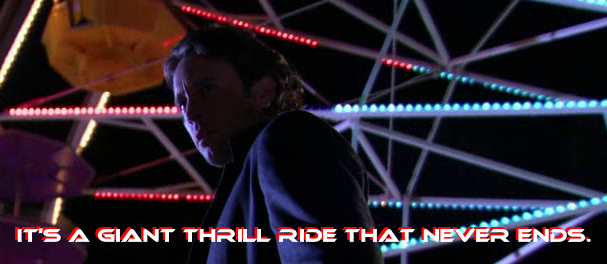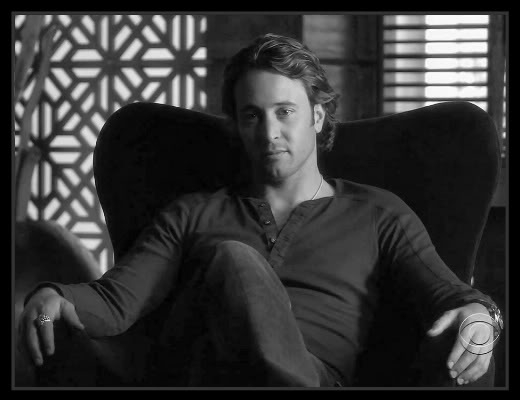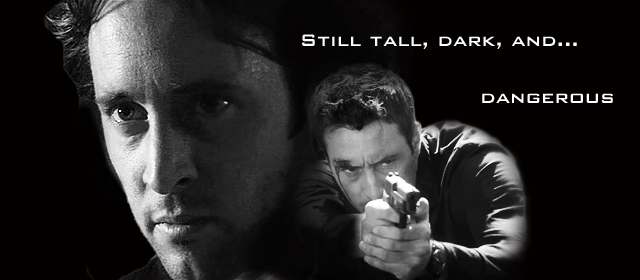
"I love the vampire genre and I love that we’ve been able to manipulate it a little bit while staying true to it. And I love that the show is done in a modern day film noir style." --Alex O'Loughlin in interview featured at http://www.pinkraygun.com/2007/09/26/on ... -part-four
"My basic approach in redefining classic vampire lore was to attempt to "noirify" the vampire mythology. I wanted to recreate the rules to reflect the themes you see repeated over and over in noir storytelling. This is why I had Mick take his blood with a needle, and sleep in a freezer to stave off his slow decay." Trevor Munson http://www.amazon.com/Angel-Vengeance-N ... +Vengeance

Definition:
"Film noir," which can be translated to "black film" or "dark film" was a term that French critics applied to a group of crime films that hit the Hollywood screen just after World War II. The term "film noir" is more of a filmmaking style rather than a specific movie genre. "...since the label of [film noir] was retrospective (and French in origin), few, if any US filmmakers thought they were making film noirs; what they were making crime films, thrillers, mysteries, and romantic meledramas." [(The Rough Guide to Film Noir)
Film noir's Development:
"Classic film noir developed during and after World War II, taking advantage of the post-war ambience of anxiety, pessimism, and suspicion. These films reflected the resultant tensions and insecurities of the time period, and counter-balanced the optimism of Hollywood's musicals and comedies. Fear, mistrust, bleakness, loss of innocence, despair and paranoia are readily evident in noir, reflecting the 'chilly' Cold War period when the threat of nuclear annihilation was ever-present. The criminal, violent, misogynistic, hard-boiled, or greedy perspectives of anti-heroes in film noir were a metaphoric symptom of society's evils, with a strong undercurrent of moral conflict, purposelessness and sense of injustice. There were rarely happy or optimistic endings in noirs." (http://www.filmsite.org/filmnoir.html )
"Oftentimes, noir could also branch out into other genre-categories, such as thrillers (i.e., Samuel Fuller's Pickup on South Street (1953)), horror films, westerns (i.e. The Gunfighter (1950)), science-fiction (i.e., Kiss Me Deadly (1955)) and even film-noir tribute-parodies, spoofs or comedies (i.e., Peeper (1975), Dead Men Don't Wear Plaid (1982)). It has been noted that a sub-category of film gris (or 'gray film') exists, according to writer Jon Tuska, meaning film noirs that have happy denouements." (http://www.filmsite.org/filmnoir.html ) Noir has also influenced televsion shows, animation, anime, comic books (particularly Batman), video games, and musicals.
Time Line:
Classic era of film noir: 1940's-1950's
Postmodern or Post-Classical noir: A film movement after the classic era that incorporates various "noir's core thematic and stylic elements." (The Rough Guide to Film Noir)
Retro-noir: Noir films made after the classic era yet they are set in the classic noir period, such as LA Confidential (1997), Chinatown (1974), and The Black Dahlia (2006).
Neo-noir: Noir films made after the classic era and are set after the classic noir period.
Tech noir (also called future noir or cyber noir): Refers to films made after the classic era that are hybrids of noir and sci-fi. Usually these films are set in the future. These category includes films such as Blade Runner (1982), The Terminator (1984), Dark City (1998), The Matrix Trilogy (1999-2002), Minority Report (2002), and Children of Men (2006).
Psycho-Noir: This is a term that some writers/critics are using that refers to neo-noirs that feature delusionary or sociopathic lead characters. Examples include movies such as Fight Club (1999) and Blue Velvet (1986).
According to "The Rough Guide to Film Noir," Film noir's "content and stylistic trademarks" were influenced by:
-- "Hollywood gangster movies"
-- "German cinema of the Weimar years and French poetic realist films of the immediate prewar period"
--"A less direct impact was made by the cycle of horror movies produced by Universal Studios in the 1930's, which in turn were influenced by the gothic novels of the nineteenth century."
--However, "of all noir's most immediate influences, the hard-boiled detective fiction [also referred to as "pulp fiction"] of the 1930's and 40's had the greatest impact. Much of noir's subject matter, characters and general milieu derived from it, in particular from the work of Dashiell Hammett, Raymond Chandler, James M. Cain, David Goodis, W.R. Burnett and Cornell Woolrich."

According to "The Rough Guide to Film Noir" by Alexander Ballinger and Danny Graydon, a typical classic film noir's storyline:
--"revolves around a doomed relationship set against the backdrop of a criminal and inverterately corrupt world."
--"The male character (a cop, private eye, war veteran, hoodlum, government operative, down-at-the heel lowlife) is caught between two women."
-- One woman is "dutiful, responsible, devoted if unexciting."
-- The other woman is "a femme fatale-- sexually alluring, linked to the underworld, unreliable and duplicitious in the extreme."
-- "The male character makes a choice (or circumstances make the choice for him) and events spiral from there, inevitably to a tragic end."
-- "The protagonists occupy a world that is dark and malign."
-- Characters often feel trapped by feelings of guilt, fear, and paranoia.
-- Characters are "often overwhelmed by the power and consequences of uncontrollable sexual desire."

According to http://www.filmsite.org/filmnoir.html, "The females in film noir were either of two types (or archetypes) - dutiful, reliable, trustworthy and loving women; or femme fatales - mysterious, duplicitous, double-crossing, gorgeous, unloving, predatory, tough-sweet, unreliable, irresponsible, manipulative and desperate women."
"The femme fatale would often be counterpointed by what film theorist Janey Place would call 'the rejuvenating redeemer'-- a woman strongly identified with traditional family values, status quo, and stability. This rejuvenating redeemer provides the film noir hero with a chance for redemption, though it is often unattainable due to the hero's own tragic flaws." (Source: Palmetto Movie Review by Anthony Leong at http://www.mediacircus.net/palmetto.html )

Marvin Rush (Moonlight's Director of photography) also talks about film noir and its relationship with Moonlight in the following Voices of Kyrpton audio interview:
http://revver.com/video/621327/vfk-inte ... rvin-rush/
From Wikpedia we also learn about some of the other common aspects of classic film noir:
Crime, usually murder, is an element of almost all film noirs; in addition to standard-issue greed, jealousy is frequently the criminal motivation. A crime investigation—by a private eye, a police detective (sometimes acting alone), or a concerned amateur—is the most prevalent, but far from dominant, basic plot. In other common plots the protagonists are implicated in heists or con games, or in murderous conspiracies often involving adulterous affairs. False suspicions and accusations of crime are frequent plot elements, as are betrayals and double-crosses. Amnesia is far more common in film noir than in real life, and cigarette smoking can seem virtually mandatory.
The characteristic heroes of noir are described by many critics as "alienated"; in the words of Silver and Ward, "filled with existential bitterness." Certain archetypal characters appear in many film noirs—hardboiled detectives, femmes fatales, corrupt policemen, jealous husbands, intrepid claims adjusters, and down-and-out writers. As can be observed in many movies of an overtly neo-noir nature, the private eye and the femme fatale are the character types with which film noir has come to be most identified, but only a minority of movies now regarded as classic noir feature either. For example, of the nineteen National Film Registry noirs, in only four does the star play a private eye: The Maltese Falcon, The Big Sleep, Out of the Past, and Kiss Me Deadly. Just two others readily qualify as detective stories: Laura and Touch of Evil.
Film noir is often associated with an urban setting, and a few cities—Los Angeles, San Francisco, New York, and Chicago, in particular—are the location of many of the classic films. In the eyes of many critics, the city is presented in noir as a "labyrinth" or "maze." Bars, lounges, nightclubs, and gambling dens are frequently the scene of action. The climaxes of a substantial number of film noirs take place in visually complex, often industrial settings, such as refineries, factories, trainyards, power plants—most famously the explosive conclusion of White Heat. In the popular (and, frequently enough, critical) imagination, in noir it is always night and it always rains.

Other important elements:
--"In terms of narrative, the best noirs routinely display sophistication, experimentation and innovation, with the most common narrative modes being the first-person voice-over, the use of flashbacks and multiple viewpoints." Ballinger and Grayden go on to state that "...noir narratives frequently possess a dream-like quality, in which objects and events are imbued with a supercharaged and forbidding aura."
--"A defining film noir characteristic (notably absent from many pseudo-noirs of modern times) is fatalism. One small misstep, such as a petty crime, minor evasion - even a ‘white lie’ - sends our doomed protagonist, typically an ‘ordinary Joe’ American male, into a quicksand of obliteration made only more intractable by his futile attempts to escape. A ‘spiderweb of deceit’ is how it’s often described. This is what happens in the noir underworld, but it tells us something of ordinary peoples’ attitudes and expectations. That such minor transgressions could lead to such out-of-control punishments suggests an air of hysteria, even moral panic." (http://www.bighousefilm.com/noir_intro.htm)

Visual cues common to film noir include:
-- city environment
-- night-time
-- dark streets
-- rain
-- neon signs or bright lights
-- smoke
-- stark light/dark contrasts (faces may be partially or fully obscured by
darkness)
-- dramatic shadows
-- low-angle shots
--Dutch angles. These are "often used to portray the psychological uneasiness or tension in the subject being filmed. A Dutch angle is achieved by tilting the camera off to the side so that the shot is composed with the horizon at an angle to the bottom of the frame." (Wikipedia)
-- the use of wide-angle lenses
-- characters or objects may appear distorted or seen from unconventional vantage points (such as reflected in mirrors or through frosted glass)


Acording to Ballinger and Graydon, "Film noir's foremorst visual signature lies in the way the films are lit; high-contrast lightings accentuates deep, enveloping shadows, while a sense of skewed reality and instability is created by the use of odd angels and wide shots." The visual style of Moonlight takes a lot from film noir, particularly the use of unusual camera angles and a lot of shots with horizontal and vertical lines (blinds.)

The sets commonly used in film noir:
--"Story locations were often in murky and dark streets, dimly-lit and low-rent apartments and hotel rooms of big cities, or abandoned warehouses." (http://www.filmsite.org/filmnoir.html)
--"Film noir is often associated with an urban setting, and a few cities—Los Angeles, San Francisco, New York, and Chicago, in particular—are the location of many of the classic films. In the eyes of many critics, the city is presented in noir as a 'labyrinth' or 'maze.'"(Wikpedia)
--"Bars, lounges, nightclubs, and gambling dens are frequently the scene of action." (Wikpedia)
-- "The climaxes of a substantial number of film noirs take place in visually complex, often industrial settings, such as refineries, factories, trainyards, power plants—most famously the explosive conclusion of White Heat." (Wikpedia)

According to "The Rough Guide To Film Noir" the sets often provide an atmosphere of:
-- claustrophobia (alleyways)
-- sleaziness (nightclubs)
-- paranoia (deserted docks)
-- temptation (opulent apartments)

"Film noir films (mostly shot in gloomy grays, blacks and whites) thematically showed the dark and inhumane side of human nature with cynicism and doomed love, and they emphasized the brutal, unhealthy, seamy, shadowy, dark and sadistic sides of the human experience. An oppressive atmosphere of menace, pessimism, anxiety, suspicion that anything can go wrong, dingy realism, futility, fatalism, defeat and entrapment were stylized characteristics of film noir. The protagonists in film noir were normally driven by their past or by human weakness to repeat former mistakes." (http://www.filmsite.org/filmnoir.html)

Please note that my main sources for this information are several websites (including Wikipedia at http://en.wikipedia.org/wiki/Film_noir ) and the book "The Rough Guide to Film Noir, by Alexander Ballinger and Danny Graydon You can learn more about this book by visiting: http://www.amazon.com/Rough-Guide-Film- ... 1843534746 Speaking of Amazon, they also has a great film noir forum with lots of great discussions about various noir topics at http://www.amazon.com/forum/film%20noir ... JGCOL1U9TM































